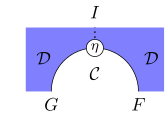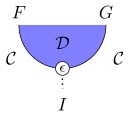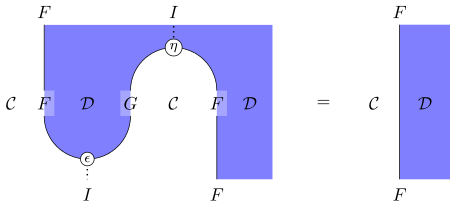String diagram
In category theory, string diagrams are a way of representing 2-cells in 2-categories.
Definition
The idea is to represent structures of dimension d by structures of dimension 2-d, using the Poincaré duality. Thus,
- an object is represented by a portion of plane,
- a 1-cell is represented by a vertical segment — called a string — separating the plane in two (the left part corresponding to A and the right one to B),
- a 2-cell is represented by an intersection of strings (the strings corresponding to f above the link, the strings corresponding to g below the link).
The parallel composition of 2-cells corresponds to the horizontal juxtaposition of diagrams and the sequential composition to the vertical juxtaposition of diagrams.

Example
Consider an adjunction between two categories and where is left adjoint of and the natural transformations and are respectively the unit and the counit. The string diagrams corresponding to these natural transformations are:



The string corresponding to the identity functor is drawn as a dotted line and can be omitted. The definition of an adjunction requires the following equalities:
The first one is depicted as

Other diagrammatic languages
Monoidal categories can also be pictured this way[1] since a strict monoidal category can be seen as a 2-category with only one object (there will therefore be only one type of plane) and Mac Lane's strictness theorem states that any monoidal category is monoidally equivalent to a strict one. The graphical language of string diagrams for monoidal categories may be extended to represent expressions in categories with other structure, such as symmetric monoidal categories, dagger categories,[2] and is related to geometric presentations for braided monoidal categories[3] and ribbon categories.[4]
External links
- TheCatsters (2007). String diagrams 1 (streamed video). Youtube.
- String diagrams in nLab
References
- ↑ Joyal, André; Street, Ross (1991). "The geometry of tensor calculus, I". Advances in Mathematics. 88 (1): 55–112. doi:10.1016/0001-8708(91)90003-P. ISSN 0001-8708. Retrieved 2016-03-21.
- ↑ Selinger, P. (2010). "A Survey of Graphical Languages for Monoidal Categories". In Bob Coecke (ed.). New Structures for Physics. Lecture Notes in Physics. Springer Berlin Heidelberg. pp. 289–355. arXiv:0908.3347
 . ISBN 978-3-642-12820-2. Retrieved 2016-03-21.
. ISBN 978-3-642-12820-2. Retrieved 2016-03-21. - ↑ Joyal, A.; Street, R. (1993). "Braided Tensor Categories". Advances in Mathematics. 102 (1): 20–78. doi:10.1006/aima.1993.1055. ISSN 0001-8708. Retrieved 2016-03-21.
- ↑ Shum, Mei Chee (1994-04-11). "Tortile tensor categories". Journal of Pure and Applied Algebra. 93 (1): 57–110. doi:10.1016/0022-4049(92)00039-T. ISSN 0022-4049. Retrieved 2016-03-21.